The document provides documentation on Ring programming language functions for working with classes, objects, attributes and methods. It summarizes over 40 functions, including classes() to get class names, isclass() to check if a class exists, packageclasses() to get classes in a package, addattribute() to add attributes to an object, and getattribute()/setattrbute() to get/set attribute values. Examples are given for each function.
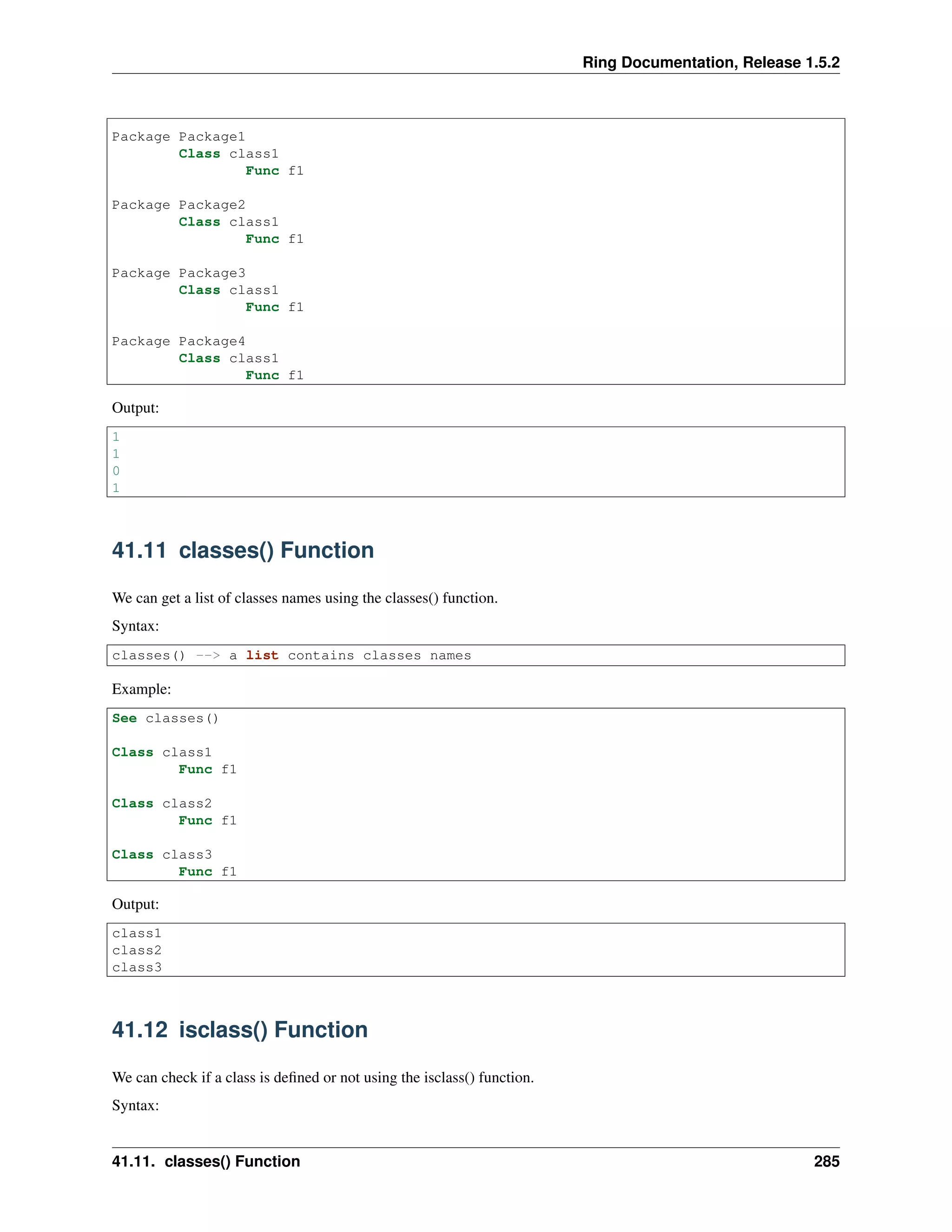

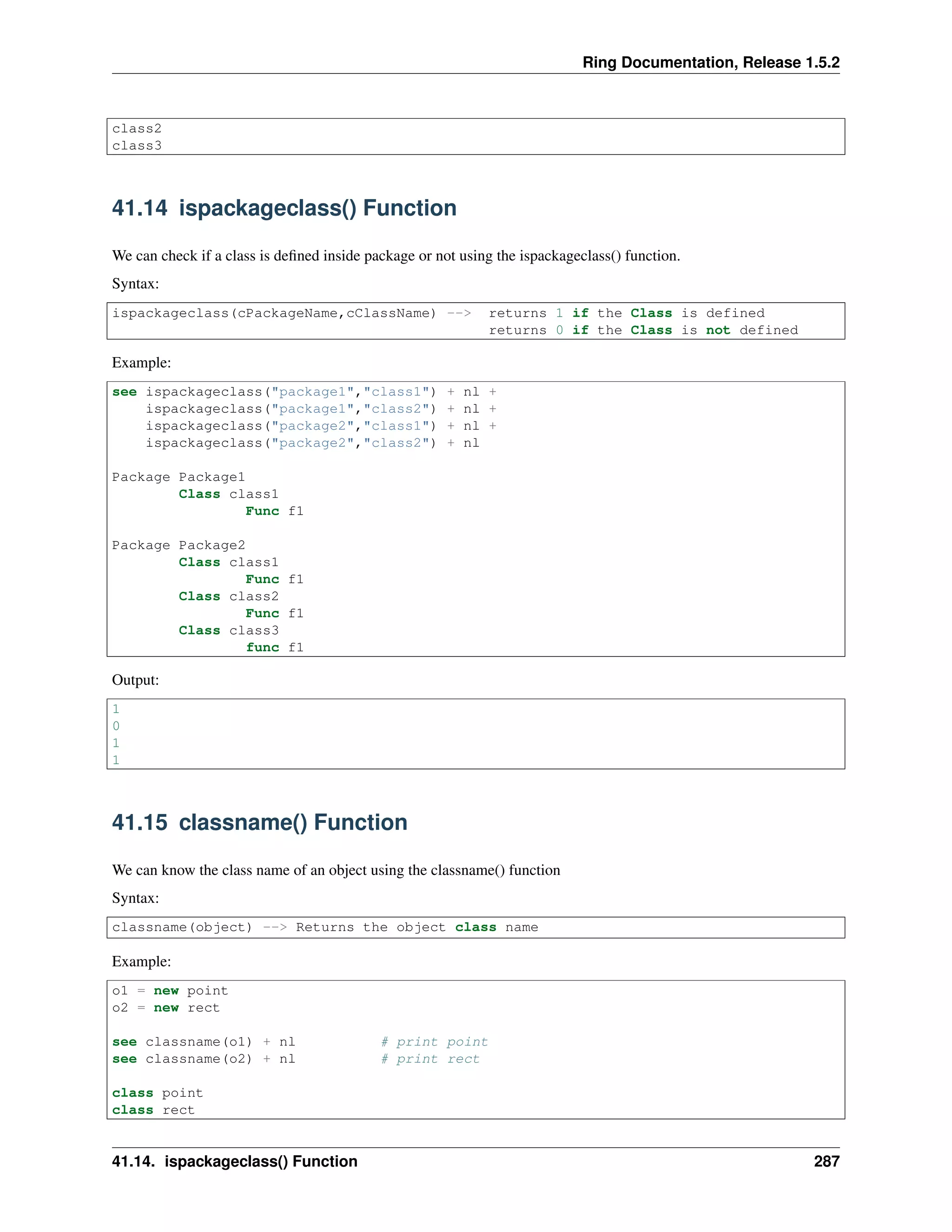
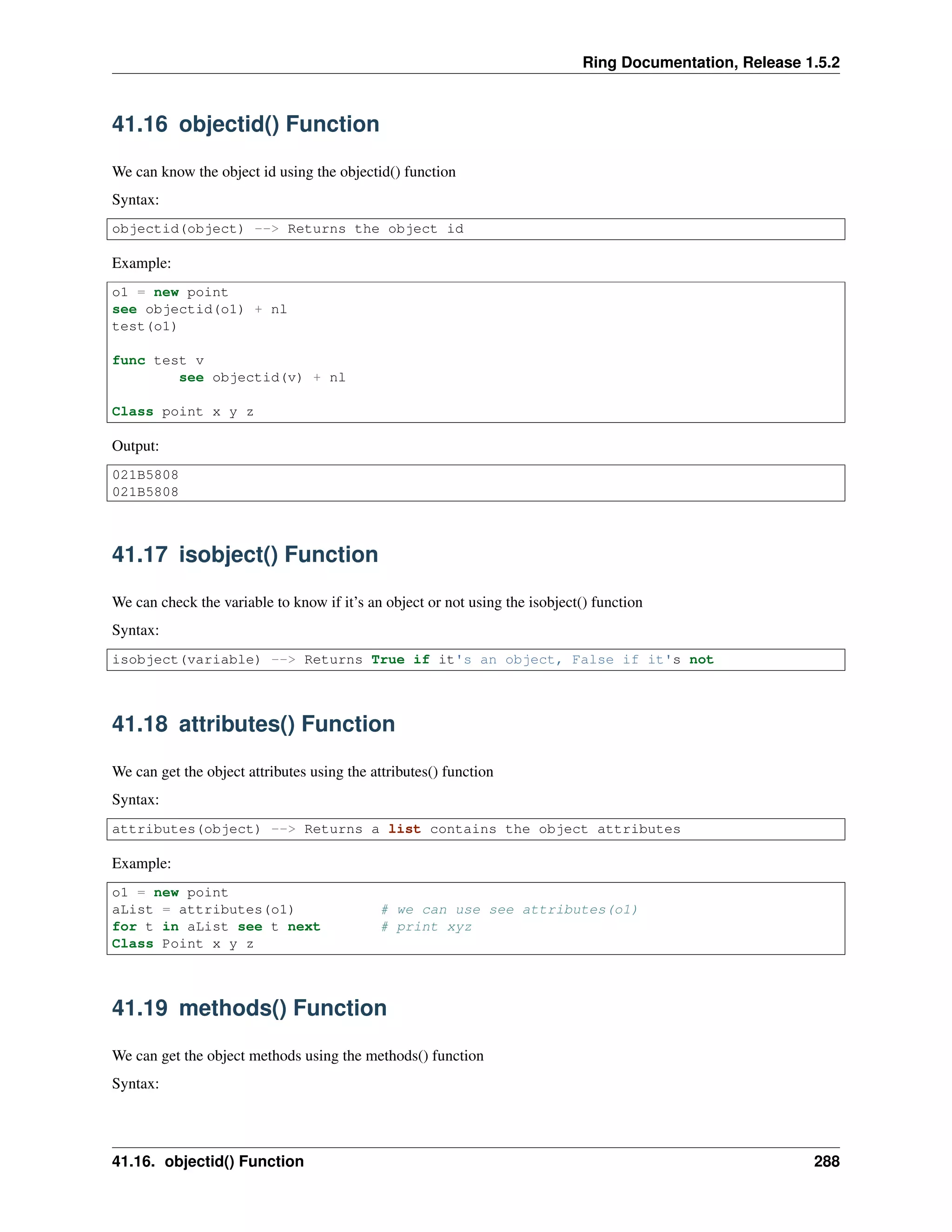
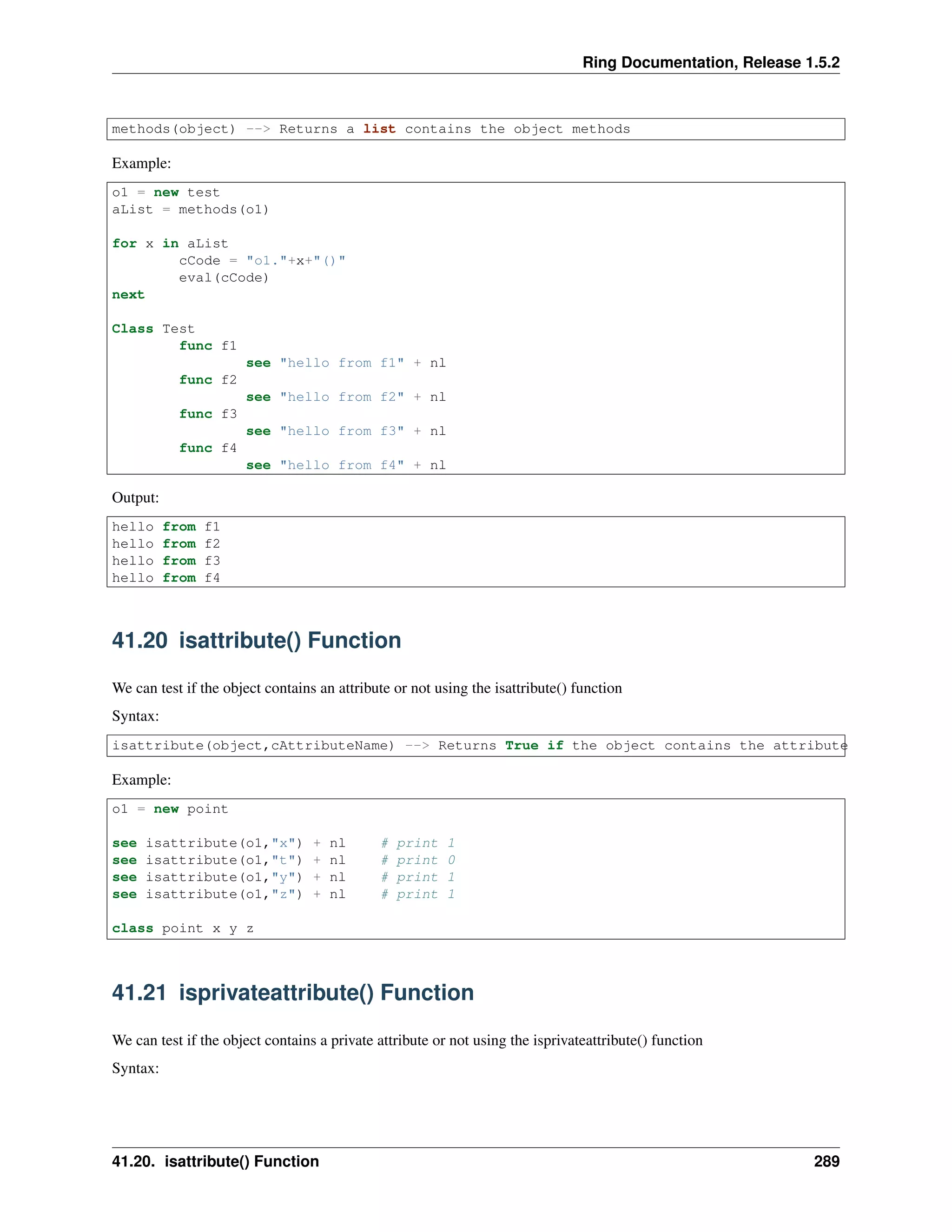
![Ring Documentation, Release 1.5.2 isprivateattribute(object,cAttributeName) --> Returns True if the object contains the private attribute Example: o1 = new person see isprivateattribute(o1,"name") + nl + isprivateattribute(o1,"address") + nl + isprivateattribute(o1,"phone") + nl + isprivateattribute(o1,"job") + nl + isprivateattribute(o1,"salary") Class Person name address phone private job salary Output: 0 0 0 1 1 41.22 ismethod() Function We can test if the object class contains a method or not using the ismethod() function Syntax: ismethod(object,cMethodName) --> Returns True if the object class contains the method Example: o1 = new point see ismethod(o1,"print") + nl # print 1 mylist = [] mylist + new point see ismethod(mylist[1],"print") + nl # print 1 class point x y z func print see x + nl + y + nl + z + nl 41.23 isprivatemethod() Function We can test if the object class contains a private method or not using the isprivatemethod() function Syntax: 41.22. ismethod() Function 290](https://image.slidesharecdn.com/311pdfsamfayedringdoc1-180227021813/75/The-Ring-programming-language-version-1-5-2-book-Part-32-of-181-6-2048.jpg)
![Ring Documentation, Release 1.5.2 isprivatemethod(object,cMethodName) --> Returns True if the object class contains the private method Example: o1 = new Test see isprivatemethod(o1,"f1") + nl + isprivatemethod(o1,"f2") Class Test func f1 see "message from f1()" + nl private func f2 see "message from f2()" + nl Output: 0 1 41.24 addattribute() Function We can add an attribute (or a group of attributes) to the object state (not the class) using the addattribute() function Syntax: AddAttribute(object,cAttributeName|aAttributesList) Example(1): see new point {x=10 y=20 z=30} Class Point AddAttribute(self,["x","y","z"]) Example(2): o1 = new point addattribute(o1,"x") addattribute(o1,"y") addattribute(o1,"z") see o1 {x=10 y=20 z=30} class point Output: x: 10.000000 y: 20.000000 z: 30.000000 41.25 addmethod() Function We can add a method to the object class using the addmethod() function This method can be used with any object from the same class. 41.24. addattribute() Function 291](https://image.slidesharecdn.com/311pdfsamfayedringdoc1-180227021813/75/The-Ring-programming-language-version-1-5-2-book-Part-32-of-181-7-2048.jpg)
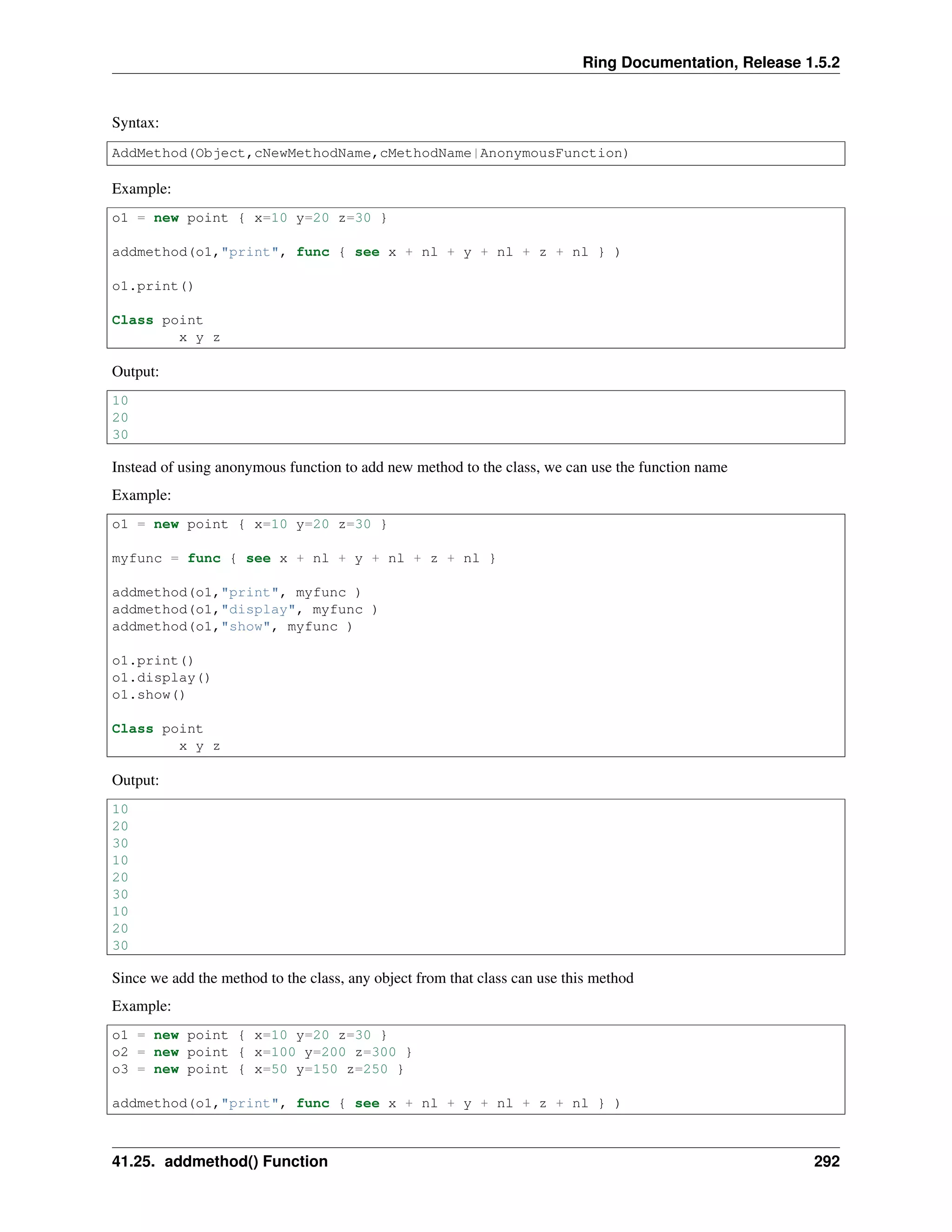
![Ring Documentation, Release 1.5.2 o1.print() o2.print() o3.print() Class point x y z Output: 10 20 30 100 200 300 50 150 250 41.26 getattribute() function We can get the object attribute value using the getattribute() function Syntax: GetAttribute(oObject,cAttributeName) ---> Attribute Value Example: o1 = new point see getattribute(o1,"name") + nl + getattribute(o1,"x") + nl + getattribute(o1,"y") + nl + getattribute(o1,"z") + nl Class Point x=10 y=20 z=30 name = "3D-Point" Output: 3D-Point 10 20 30 Example: We can Find a Class List Member using GetAttribute() using a function findclass() The Find uses the member name, rather than the column number myList = [new Company {position=3 name="Mahmoud" symbol="MHD"}, new Company {position=2 name="Bert" symbol="BRT"}, new Company {position=1 name="Ring" symbol="RNG"} ] 41.26. getattribute() function 293](https://image.slidesharecdn.com/311pdfsamfayedringdoc1-180227021813/75/The-Ring-programming-language-version-1-5-2-book-Part-32-of-181-9-2048.jpg)
![Ring Documentation, Release 1.5.2 see myList see nl +"=====================" + nl + nl for i = 1 to len(myList) see "Pos: "+ i +" | "+ myList[i].position +" | "+ myList[i].name + " | "+ myList[i].symbol +" | "+ nl next See findclass(myList, "MHD", "symbol") +nl ### Specify Member class name ###--------------------------------------- func findclass classList, cValue, classMember See nl + "FindClass: " +" "+ cValue + nl + nl for i = 1 to len(classList) result = getattribute( classList[i], classMember ) See "Result-Attr: " + i +" "+ result +nl if result = cValue j = i ok next return j ###-------------------------------------- class company position name symbol Output: Pos: 1 | 3 | Mahmoud | MHD | Pos: 2 | 2 | Bert | BRT | Pos: 3 | 1 | Ring | RNG | FindClass: MHD Result-Attr: 1 MHD Result-Attr: 2 BRT Result-Attr: 3 RNG 1 41.27 setattribute() function We can set the object attribute value using the setattribute() function Syntax: SetAttribute(oObject,cAttributeName,Value) Example: o1 = new person setattribute(o1,"cName","Mahmoud") 41.27. setattribute() function 294](https://image.slidesharecdn.com/311pdfsamfayedringdoc1-180227021813/75/The-Ring-programming-language-version-1-5-2-book-Part-32-of-181-10-2048.jpg)